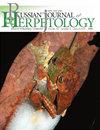摩尔多瓦德涅斯特河流域水蛙(Pelophylax esculentus complex)的分布、种群系统及杂交配子发生特性
IF 0.9
4区 生物学
Q3 ZOOLOGY
引用次数: 0
摘要
杂交发生是Pelophylax属水蛙众所周知的特性。P.esculentus复合体由两个亲本物种,P.lessonae和P.ridibundus,以及它们的半克隆(有时是亚克隆)杂交种,P.esculent组成。使用DNA流式细胞术、遗传和形态计量学分析来检测摩尔多瓦德涅斯特河流域27个地区(n=212)的水蛙成分。在研究区域内发现了两个物种(42%的个体是埃斯库伦特斯和58%的ridibundus)。所有的青蛙都被证明是二倍体。我们在74%的地区登记了第一个物种,在78%的地方登记了第二个物种。在种群中,我们发现只有P.ridibundus出现在26%的地区,只有P.esculentus出现在22%的地区,而混合种群系统出现在52%的地区。这两种物种通常在开阔的水体和流经农田和城市地区的河流中观察到。在P.esculentus种群中,雄性的数量远远超过雌性的数量(90%)。所研究的杂交雄性中有一半是不育的,而大多数可育的杂交雄性产生的精子都带有P.lessonae的基因组。几只杂交雄性的精子混合了lessonae和P.ridibundus(两精子)的基因组,只有一只雄性的精子具有P.ridibondus基因组。这两个物种都具有ridibundus的线粒体DNA。基于核标记,在P.esculentus和P.ridibundus中,我们揭示了密切相关的安纳托利亚物种P.cf.bbedriagae的等位基因的存在。这可能会影响杂交遗传的埃斯库伦特斯的成功繁殖。然而,不育雄性的百分比和P.cf.bedriagae等位基因在杂交种之间的比较没有显示出相关性。本文章由计算机程序翻译,如有差异,请以英文原文为准。
Distribution, Population Systems, and Peculiarities of Hybrid Gametogenesis in Water Frogs (Pelophylax esculentus complex) in the Dniester River Valley (Moldova)
Hybridogenesis is well-known attributes of water frogs of the genus Pelophylax. The P. esculentus complex consists of two parental species, P. lessonae and P. ridibundus, as well as their hemiclonal (sometimes meroclonal) hybrid, P. esculentus. DNA flow cytometry, genetic and morphometric analyses were used to examine water frog compositions in 27 localities (n = 212) throughout the Dniester River valley in Moldova. Two species were revealed in the studied region (42% individuals were P. esculentus and 58% P. ridibundus). All frogs proved to be diploid. We registered the first species in 74% localities and the second in 78%. Populations, where we found only P. ridibundus occurred in 26% localities and only P. esculentus in 22%, while mixed population systems in 52%. Both species were usually observed in open water bodies and rivers that flow down through agricultural land and urban areas. In populations of P. esculentus the number of males strongly exceeded (90%) the number of females. The half of studied hybrid males was sterile, and most of fertile hybrid males produced sperm with the genome of P. lessonae. Several hybrid males gave the mixture of sperm with genomes of P. lessonae and P. ridibundus (amphispermy) and only one male with the P. ridibundus genome. Both species had the mitochondrial DNA of P. ridibundus. Based on nuclear markers, in P. esculentus and P. ridibundus we revealed the presence of alleles of the closely related Anatolian species P. cf. bedriagae. This might affect the successful reproduction of hybridogenetic P. esculentus. However, comparison of percentage of sterile males and alleles of P. cf. bedriagae among hybrids showed no correlation.
求助全文
通过发布文献求助,成功后即可免费获取论文全文。
去求助
来源期刊

Russian Journal of Herpetology
ZOOLOGY-
CiteScore
1.70
自引率
0.00%
发文量
29
期刊介绍:
Russian Journal of Herpetology is an international multi-disciplinary journal devoted to herpetology. Russian Journal of Herpetology accepts original papers on ecology, behavior, conservation, systematics, evolutionary morphology, paleontology, physiology, cytology and genetics of amphibians and reptiles.
Types of Contributions:
-original papers
-invited or contributed reviews on specific topics
-short communications on topics of immediate interest, new methods and ideas in progress
-notices of meetings, symposia, and short courses
-book reviews
 求助内容:
求助内容: 应助结果提醒方式:
应助结果提醒方式:


